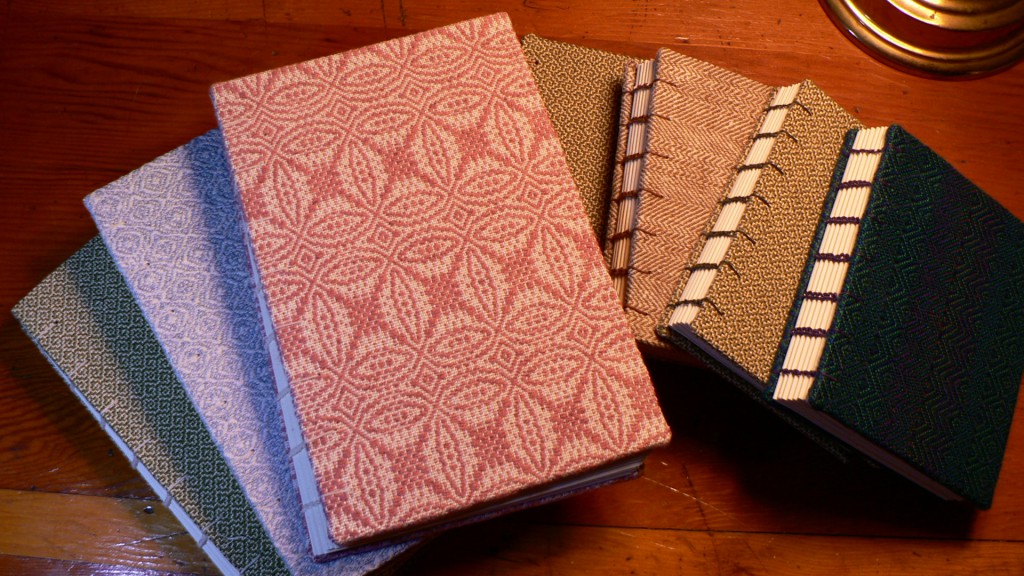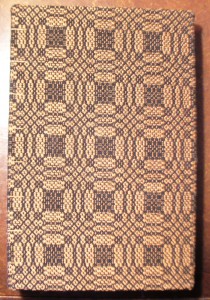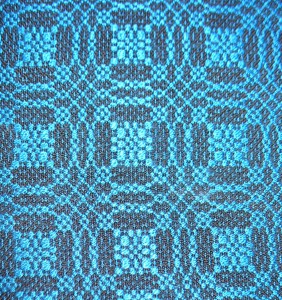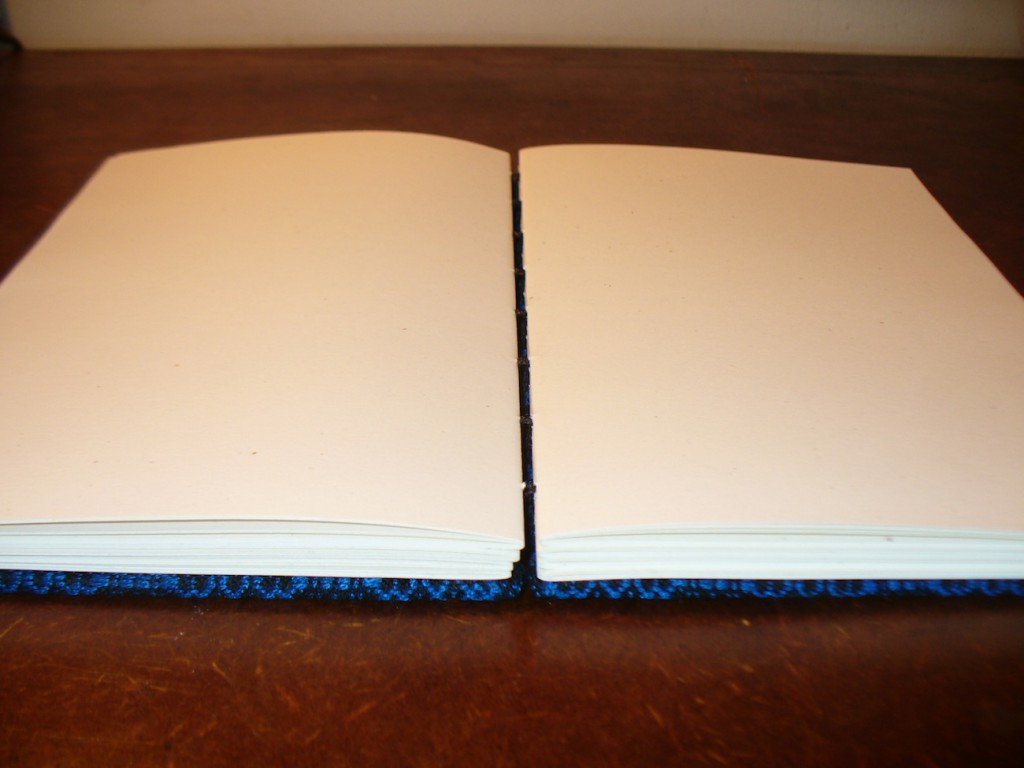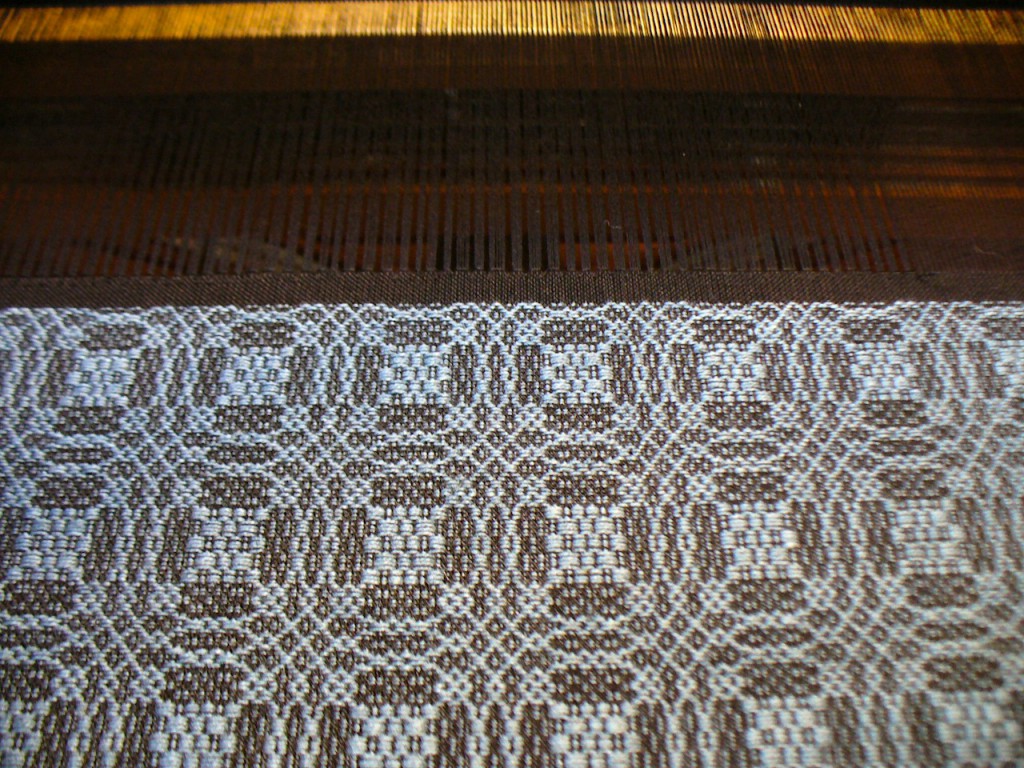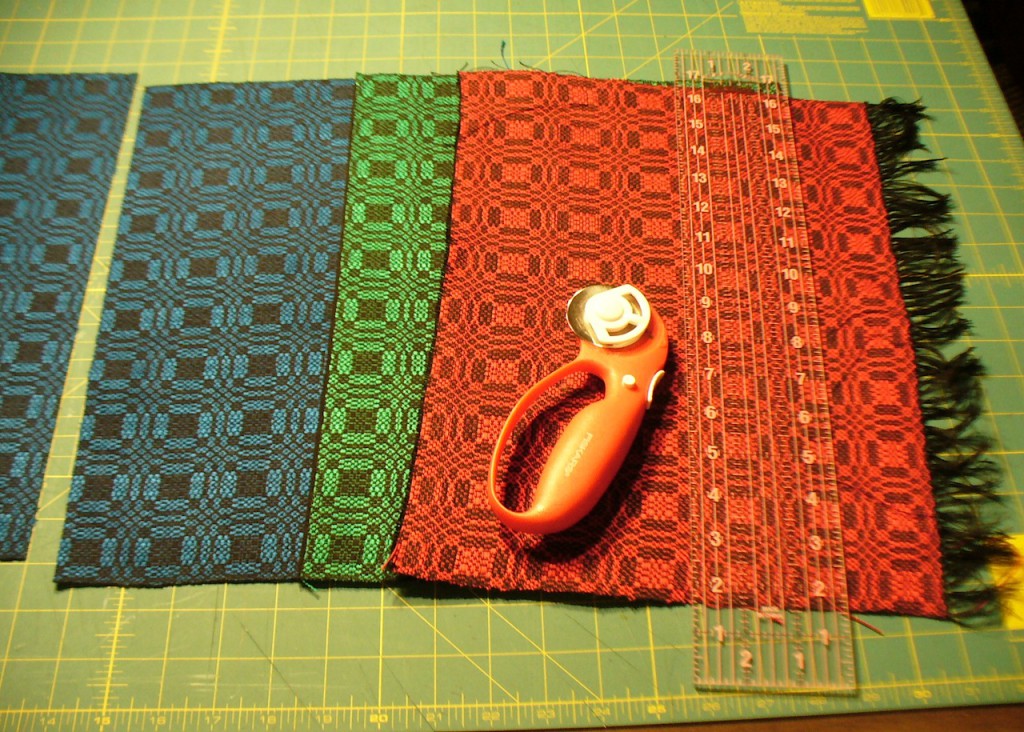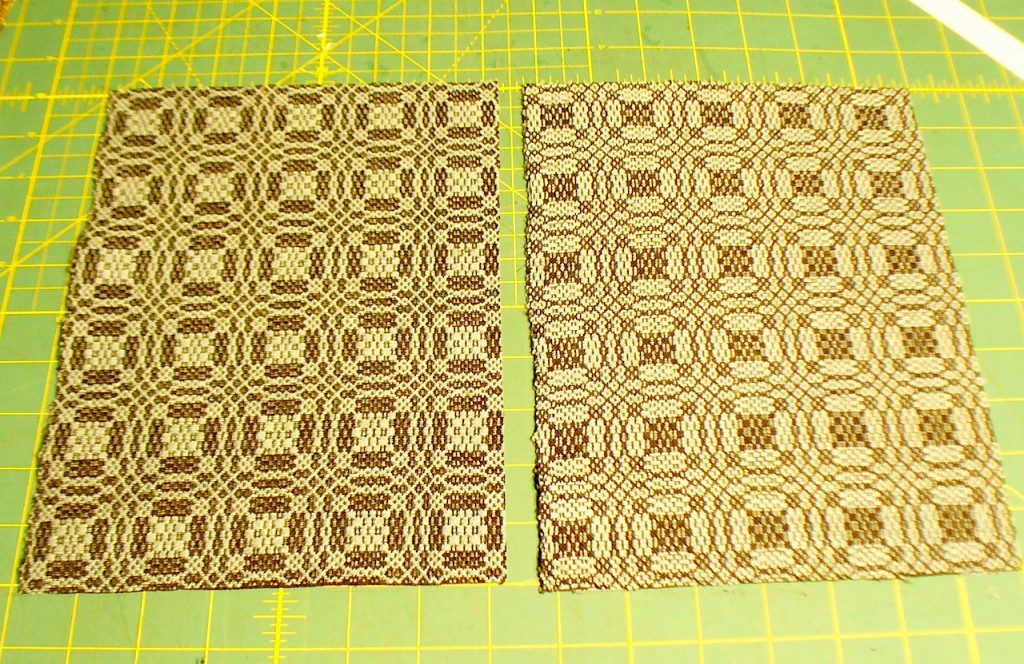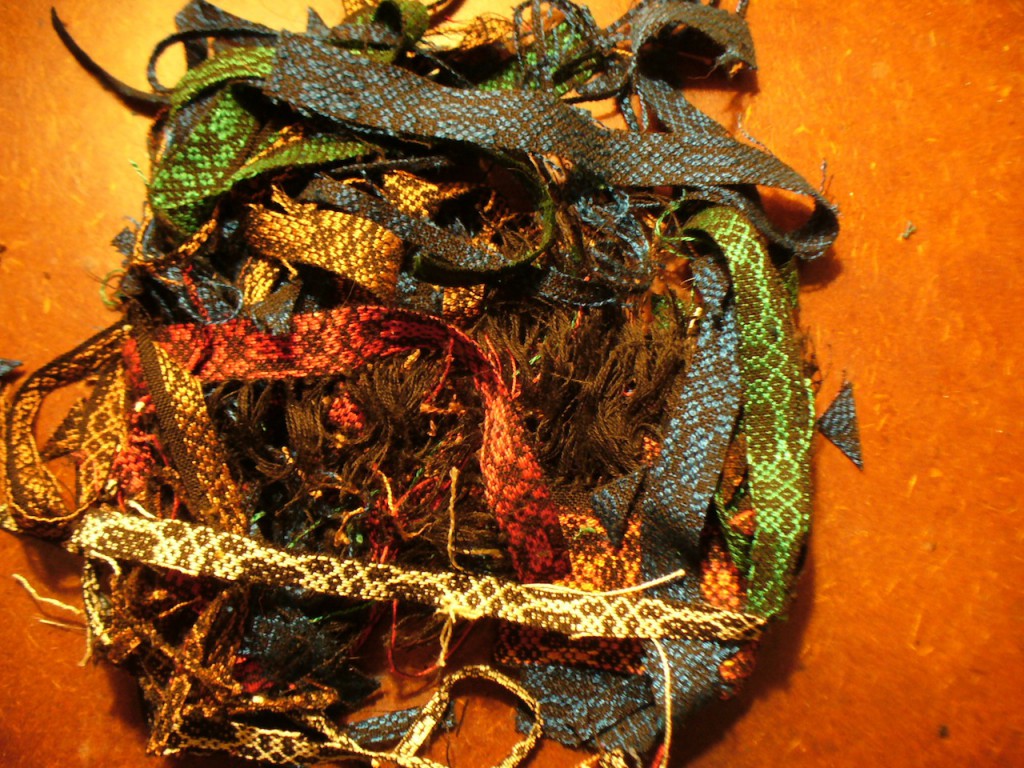On Wednesday November 14th I gave a presentation to the Weavers of Western Massachusetts (12/24/2023 Edited to add, they have a website now so I added a link!) about my Coptic bound books with handwoven cloth covers. It was very flattering to be invited to share my work with such an accomplished group of weavers, and I really appreciated the opportunity to talk about my process to an interested audience. It was a lot of fun. Continue reading “Guild Presentation”
More journals
This weekend I sewed together the last of the books from the Young Lovers Knot warp. Three have blue 10/2 tencel for the pattern weft (the color is called Moroccan Blue from Textiva Yarns) with black 20/2 tabby weft. One has a copper-colored 10/2 cotton pattern weft (a UKI color called Mead) with black 20/2 tabby, and one has green 10/2 tencel (Emerald Green from Textiva Yarns) pattern weft with 20/2 black tabby.
Here are a few more details about them. The coptic binding lets the journal open flat as you write. This is an advantage because you can write anywhere (e.g., sitting snug in bed with your journal propped on your knees). Also, you don’t waste any paper because you can write all the way to the edges.
These journals are meant for writing, rather than drawing or painting. The paper is smooth, so you can write without bumps and lumps. Any kind of pen will work (except Sharpie bleeds through). I prefer old-fashioned ball points, my pen of choice for decades. The paper isn’t too plain, though, it has visual texture, with little flecks of light brown against the cream-colored paper.
The spines are exposed so you see the folds of the signatures, and the coptic stitch is decorative. I like how the stitching extends the feeling of the threads in the cloth on the covers. It makes the books feel connected, like the covers and pages grew together.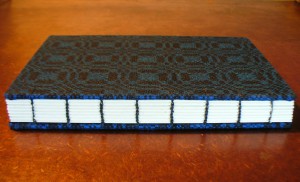
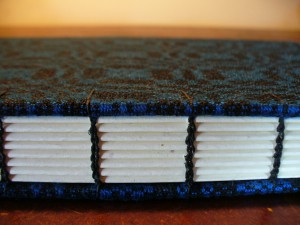
Matching the color of the waxed linen thread with the yarns in the cover is fun, though not straightforward. I bought certain colors of waxed linen thread specifically because they matched the yarns I have. But when the cloth is all woven together, interactions between the pattern yarn and the tabby yarn create new color effects. This is always true with weaving, but it happens in a particular way with overshot because of the interactions of the tabby weft with the pattern weft, as well as the warp. Because of these interactions, two colors that were similar when compared one-on-one no longer look alike. I prefer the color of the waxed linen thread to blend into the cloth on the covers. To me it adds to the feeling that the cloth and the stitching are one process or one structure.
My journals are no longer available at Food for Thought Books, since they are in the midst of textbook rush and the space is filled with books for classes for the new semester. For the moment, I have them here at home. Here is the description I posted with the books at the store:
“These books were handmade by Michelle Parrish of Local Color Dyes and Wood Thrush Weaving – Amherst, MA. I hand wove the cloth for the covers using cotton, tencel, and cotton-linen blend yarns. The pattern is a variation on a traditional overshot motif called “Young Lovers’ Knot.” I sewed the books with a Coptic binding using waxed linen thread. In addition to being decorative, the Coptic binding allows your book to lay flat as you write. The writing paper is 50% post consumer recycled, acid free, and FSC certified. Though all the books in this series share the same pattern, each book is one of a kind.
I made these books so that people could write in them. Writing helps me make sense and meaning of my life, to re-tell and remember, to think, plan and decide, and to create continuity and a sense of personal history over time. It connects me to myself. I have kept a journal since I was 7 years old.
The overshot pattern on the cover holds a story of its own, and is connected to a longer history. In times past, these patterns were woven with linen or cotton and wool, and made warm, durable bed covers. Many old coverlets were made entirely by hand and represented months of work: the linen was grown, processed, and spun, and the wool sheared, washed, spun, and dyed, by the weaver and her family. There are hundreds of traditional overshot patterns, many with evocative names. Each of us lives a unique story of our own, but we are all connected to one another, past and present, through the fabric of life. I hope one of these books will connect you to others who labored, created, lived and loved, and passed their stories to us in the form of these traditional patterns.
And I hope these journals offer a space to write some of your own story.”
More About My Books
Well, the Cottage Street Studios open house was very interesting. Here’s a photo of my books and some of Amanda’s gilded acorns, wishbones, and gourds around a festive winter-time tree. 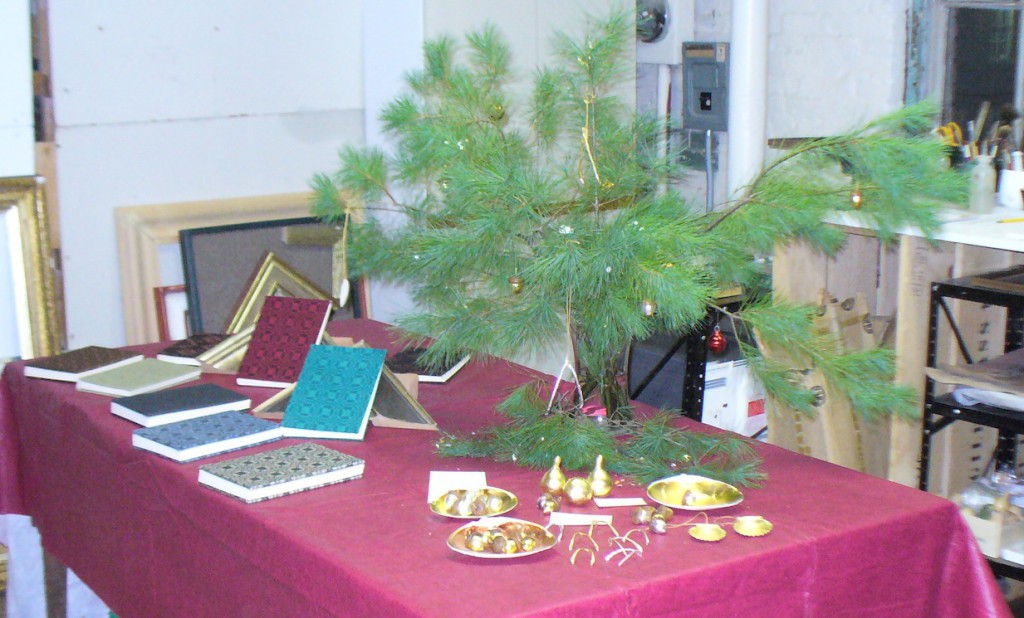 She also makes stunning gilded panels, frames, and other treasures. I met lots of great people and had inspiring conversations. My books have now moved to Food For Thought Books in Amherst where they are available for sale. Here they are on display at the bookstore:
She also makes stunning gilded panels, frames, and other treasures. I met lots of great people and had inspiring conversations. My books have now moved to Food For Thought Books in Amherst where they are available for sale. Here they are on display at the bookstore: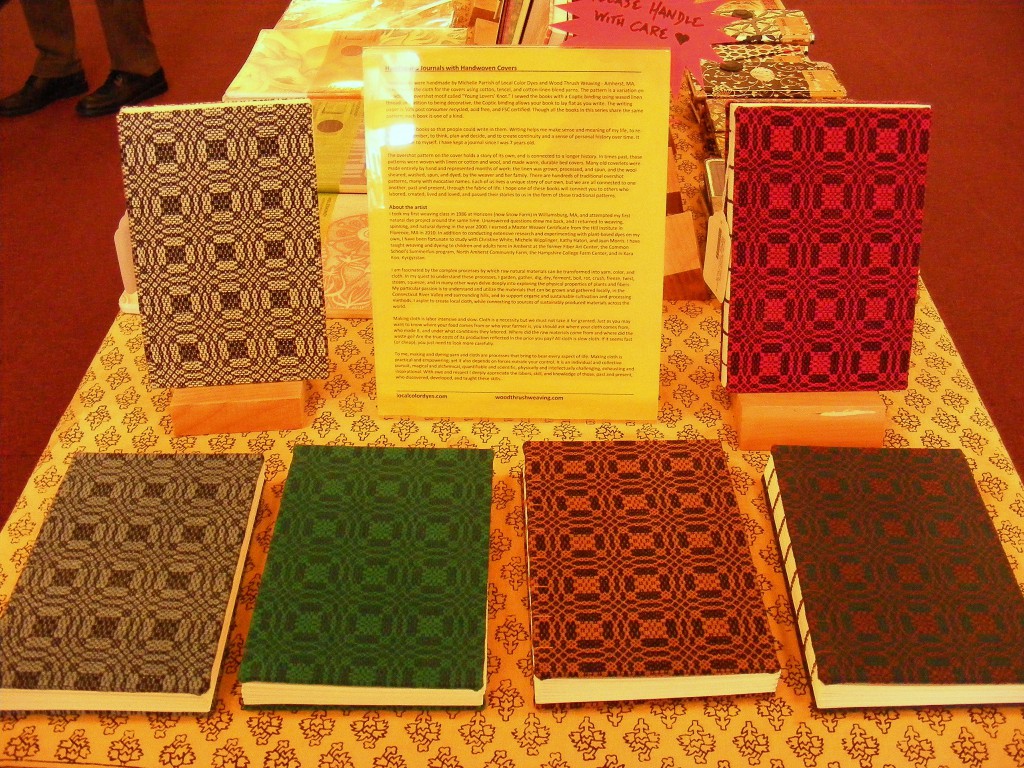 Making these books is a multi-step process. I haven’t photographed every step, but I thought I should give an overview. Understanding the process helps people to understand the labor and expense involved in creating a handmade object.
Making these books is a multi-step process. I haven’t photographed every step, but I thought I should give an overview. Understanding the process helps people to understand the labor and expense involved in creating a handmade object.
First I wove the cloth, using a variation of the traditional overshot pattern called Young Lovers’ Knot. This involved calculations about the sizes of the books and shrinkage of the cloth, as well as all the steps involved in dressing a loom. I put on a warp long enough to make 12 books. Even though I really loved the pattern and enjoyed playing around with different color combinations, I was happy to get to the end of the warp when I finally finished it; it took a long time to weave. The pattern requires two shuttles, one with a thin thread (20/2, same size as the warp) and one with a thicker thread that makes the pattern. So, it went slowly. Here’s the end of the warp.
Then I washed, dried, and ironed the cloth, and cut it into sections.
Then, for each book I decided whether to show the front or back of the cloth, because the two sides look very different. For example, in the photo of the black and white cloth, the piece on the left, with the white squares (tables) in the center of the round motif, shows the “right” side of the cloth. With this color combination, I preferred the back side.
I used a paper template to center the pattern on the cover. I am a symmetry fan, so I was going for symmetry even if I didn’t always attain it. Cloth has a mind of its own. Once I framed the portion of the pattern that I liked, I cut the cloth to size, and glued the cloth onto book board (8.5 inches by 5.5 inches) with PVA glue.
I managed to waste very little cloth in this process, which on the one hand I was pleased about because the cloth took so long to weave that I didn’t want to waste it. On the other hand, I might give myself more of an allowance next time (i.e., weave a couple more pattern repeats in width and length) to give me more design flexibility. Here are my scraps:
Then I trimmed the corners, and glued down the edges of the cloth on the inside of the cover. Then I pressed the covers. When they were dry, I cut and glued down nice papers on the inside of the covers. Matching paper colors and cloth colors is also a whole decision-making process. Here’s me gluing down the papers.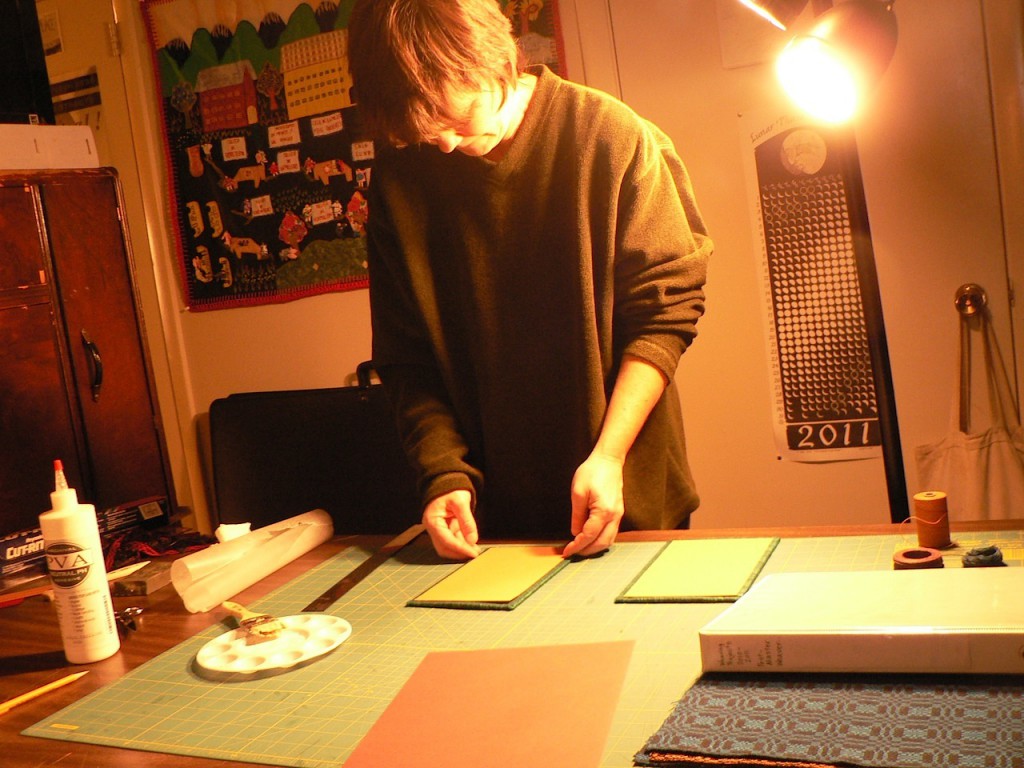 Then I pressed the covers again until the glue was dry. Meanwhile, I folded the signatures, and put them under weights for a while. When the covers were dry, I punched holes in the signatures and holes in the covers with an awl, and sewed the whole thing together with 4 ply waxed linen thread. Ta-da, a book. Six are done, and six more are in the works.
Then I pressed the covers again until the glue was dry. Meanwhile, I folded the signatures, and put them under weights for a while. When the covers were dry, I punched holes in the signatures and holes in the covers with an awl, and sewed the whole thing together with 4 ply waxed linen thread. Ta-da, a book. Six are done, and six more are in the works.
New Handbound Books with Handwoven Covers
Today I am bringing my new crop of handbound books to the Cottage Street Open Studios, where my friend Amanda kindly invited me to offer them for sale alongside her gorgeous gilded pieces.
The cloth for the covers of my new books is woven in a traditional overshot pattern called Young Lovers’ Knot. I wanted the scale of the pattern to be small and intricate, so the warp and tabby weft are 20/2 cotton. The pattern wefts are 10/2 cotton, 10/2 tencel, and 22/2 cottolin. The cottolin is a blend, 60% cotton/40% linen, and I hand dyed it blue with woad from my garden. The rest are commercially dyed. The cloth took a ridiculously long time to weave. Then there was the problem of where to dry it since it was very long. It dried inside and outside.
 I wove two pieces without the emboldening tabby, a red one and a green one. So, the cloth for this red book is a small piece of history, now made famous right here in this post!
I wove two pieces without the emboldening tabby, a red one and a green one. So, the cloth for this red book is a small piece of history, now made famous right here in this post!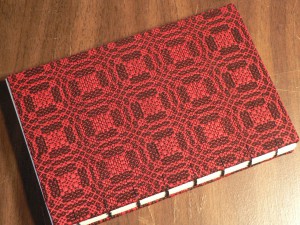 After the first two pieces, I resolved my emboldening tabby problem. To make sure your emboldening tabby stays consistent, you need an even number of picks at each turning point in the pattern, i.e., in the center and at the end. I had added a pick at the end of the pattern, but later decided to take out two picks in the center of the pattern. This created a shorter, less busy-looking square or “table” in the pattern.
After the first two pieces, I resolved my emboldening tabby problem. To make sure your emboldening tabby stays consistent, you need an even number of picks at each turning point in the pattern, i.e., in the center and at the end. I had added a pick at the end of the pattern, but later decided to take out two picks in the center of the pattern. This created a shorter, less busy-looking square or “table” in the pattern.
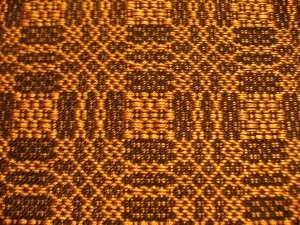 Each book is unique. Here are a few photos of the books:
Each book is unique. Here are a few photos of the books:

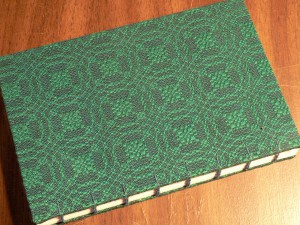
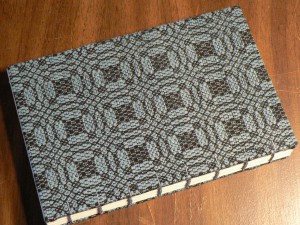
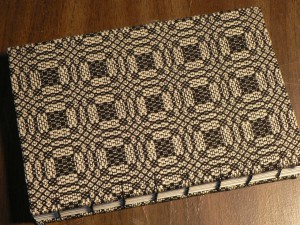
Small Ones Farm
Many thanks to Sally and Bob Fitz of Small Ones Farm for inviting me to table at their fruit CSA pick up days on Saturday October 1st and Wednesday October 19th. It was very inspiring to meet their members, and I had many stimulating conversations about CSAs, locally sourced materials, natural dyes, local wool, flax, and vegan cloth.
At my table I displayed a basket of naturally dyed wool yarns that were mostly handspun by me, over the years, using natural dyes. For the madder, I displayed the results of a dye bath using roots from Earth Guild. (I have also bought madder root from Tierra Wools and Aurora Silk.) For all the rest, I used plants I gathered or grew myself in Amherst or the surrounding area. When I first began spinning, the most economical way to acquire a lot of wool was to buy raw fleeces. I bought and have enjoyed working with Corriedale from the former Mad Women’s Farm in Amherst, Dorset/Border Leicester cross from Natural Roots in Conway, Coopworth from Shirkshire Farm in Conway, the mixed breed flock at Hampshire College, and Romney and mohair from a few farmers I met at the Webs fleece markets. After I got tired of washing and carding my own wool, I’ve enjoyed roving from Balkey farm in Northfield and others. I also had a smaller basket of naturally dyed linen (commercial 40/2 from Webs). The yarns (and my bundle of home grown flax) were for show and tell.
And for sale, I had handbound books with handwoven cloth covers.
